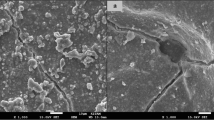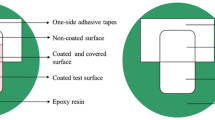Abstract
This paper details a novel method to improve wear resistance of dental glass ionomer cement (GIC) restorations. The purpose of this in vitro study was to evaluate the effect of a calcium chloride (CaCl2) solution treatment on surface hardness, surface roughness, compressive strength, water sorption and solubility of three conventional glass ionomer cements (GICs). Additionally, the changes of the Ca composition and morphology of the surface of the tested GICs were also investigated. The experimental groups of the study were: Group 1 (control) specimens after mixing were left in the mold to set without any treatment for 5 min; Group 2 specimens were left in the mold to set for 5 min and then each specimen was immersed in 10 ml of 42.7 wt% CaCl2 solution for 60 s. Statistical analysis was performed using one-way ANOVA and Tukey post hoc tests (a = 0.05). Calcium chloride solution treatment increased surface hardness of the GICs compared to control groups (P < 0.05), while surface roughness and compressive strength did not change after the treatment (P > 0.05). Reduction in water sorption and solubility was detected but not in all CaCl2 solution-treatment groups. No alterations were observed in surface morphology of the GICs, while surface calcium composition was increased after the treatment (P < 0.05). The use of a CaCl2 solution immediately after initial setting of GICs may be advantageous for some properties of the materials and possibly leads to improved prognosis and wear resistance of their restorations.



Similar content being viewed by others
References
Dionysopoulos D, Koliniotou-Koumpia E, Helvatzoglou-Antoniades M, Kotsanos N. Fluoride release and recharge ability of contemporary fluoride-containing restorative materials and dental adhesives. Dent Mater J. 2013;32:296–304.
Tamilselvam S, Divyanand MJ, Neelakantan P. Biocompatibility of a conventional glass ionomer, ceramic reinforced glass ionomer, giomer and resin composite to fibroblasts: in vitro study. J Clin Pediatr Dent. 2013;37:403–6.
Nicholson JW. Adhesion of glass ionomer cements to teeth: a review. Int J Adhes Adhes. 2016;69:33–8.
Yan Z, Sidhu SK, Carrick TE, McCabe JF. Response to thermal stimuli of glass ionomer cements. Dent Mater. 2007;23:597–600.
Gu S, Rasimick BJ, Deutsch AS, Musikant BL. In vitro evaluation of five core materials. J Prosthodont. 2007;16:25–30.
Kleverlaan CJ, van Duinen RNB, Feilzer AJ. Mechanical properties of glass ionomer cements affected by curing methods. Dent Mater. 2004;20:45–50.
de Gee AJ, van Duinen RN, Werner A, Davidson CL. Early and long-term wear of conventional and resin-modified glass ionomers. J Dent Res. 1996;75:1613–9.
Ilie N, Hickel R, Valceanu AS, Huth KC. Fracture toughness of dental restorative materials. Clin Oral Investig. 2012;16:489–98.
Peutzfeldt A, García-Godoy F, Asmussen E. Surface hardness and wear of glass ionomers and compomers. Am J Dent. 1997;10:15–7.
Bonifácio CC, Kleverlaan CJ, Raggio DP, Werner A, de Carvalho RC, van Amerongen WE. Physical-mechanical properties of glass ionomer cements indicated for atraumatic restorative treatment. Aust Dent J. 2009;54:233–7.
Silva RM, Santos PHN, Souza LB, Dumont VC, Soares JA, Santos MH. Effects of cellulose fibers on the physical and chemical properties of glass ionomer dental restorative materials. Mater Res Bull. 2013;48:118–26.
Najeeb S, Khurshid Z, Zafar MS, Khan AS, Zohaib S, Marti JMN, et al. Modifications in glass ionomer cements: nano-sized fillers and bioactive nanoceramics. Int J Mol Sci. 2016;17:1134.
Tolidis K, Dionysopoulos D, Gerasimou P, Sfeikos T. Effect of radiant heat and ultrasound on fluoride release and surface hardness of glass ionomer cements. J Appl Biomater Funct Mater. 2016;14:e463–9.
Gavic L, Gorseta K, Glavina D, Czarnecka B, Nicholson JW. Heat transfer properties and thermal cure of glass-ionomer dental cements. J Mater Sci Mater Med. 2015;26:249.
Menne-Happ U, Ilie N. Effect of heat application on the mechanical behaviour of glass ionomer cements. Clin Oral Investig. 2014;18:643–50.
Dionysopoulos D, Tolidis K, Strakas D, Gerasimou P, Sfeikos T, Gutknecht N. Effect of radiant heat on conventional glass ionomer cements during setting by using a blue light diode laser system (445 nm). Lasers Med Sci. 2017;32:703–9.
Dehurtevent M, Deveaux E, Hornez JC, Robberecht L, Tabary N, Chai F. Influence of heat and ultrasonic treatments on the setting and maturation of a glass-ionomer cement. Am J Dent. 2015;28:105–10.
Towler MR, Bushby AJ, Billington RW, Hill RG. A preliminary comparison of the mechanical properties of chemically cured and ultrasonically cured glass ionomer cements, using nano-indentation techniques. Biomaterials. 2001;22:1401–6.
Shiozawa M, Takahashi H, Iwasaki N, Wada T, Uo M. Effect of immersion time of restorative glass ionomer cements and immersion duration in calcium chloride solution on surface hardness. Dent Mater. 2014;30:e377–83.
Shiozawa M, Takahashi H, Iwasaki N, Uo M. Effect of calcium chloride solution immersion on surface hardness of restorative glass ionomer cements. Dent Mater J. 2013;32:828–33.
Dionysopoulos D, Tolidis K, Gerasimou P, Sfeikos T. Effect of three clinical curing treatments on fluoride release and surface hardness of glass ionomer cements. Int J Periodontics Restor Dent. 2017;37:e197–203.
Musanje L, Shu M, Darvell B. Water sorption and mechanical behaviour of cosmetic direct restorative materials in artificial saliva. Dent Mater. 2001;17:394–401.
Leach R. In: Characterisation of areal surface texture. Chapter: The areal field parameters. Springer, p. 15–43.
Dionysopoulos D, Tolidis K, Sfeikos T, Karanasiou C, Parisi X. Evaluation of surface microhardness and abrasion resistance of two dental glass ionomer cements after radiant heat treatment. Adv Mater Sci Eng 2017 Article ID: 5824562.
Heintze SD, Zellweger G, Zappini G. The relationship between physical parameters and wear of dental composites. Wear. 2007;263:1138–46.
Nicholson JW, McKenzie MA, Goodridge R, Wilson AD. Variations in the compressive strength of dental cements stored in ionic or acidic solutions. J Mater Sci Mater Med. 2001;12:647–52.
Nicholson JW. Studies in the setting of polyelectrolyte cements: part VII. The effect of divalent metal chlorides on the properties of zinc polycarboxylate and glass-ionomer dental cements. J Mater Sci Mater Med. 1998;9:273–7.
Nicholson JW, Wilson AD. The effect of storage in aqueous solutions on glass-ionomer and zinc polycarboxylate dental cements. J Mater Sci Mater Med. 2000;11:357–60.
Zankuli MA, Delvin H, Silikas N. Water sorption and solubility of core built-up materials. Dent Mater. 2014;30:e324–9.
Martin N, Jedynakiewicz N. Measurement of water sorption in dental composites. Biomaterials. 1998;19:77–83.
Calvo AFB, Kicuti A, Tedesco TK, Braga MM, Raggio DP. Evaluation of the relationship between the cost and properties of glass ionomer cements indicated for atraumatic restorative treatment. Braz Oral Res. 2016;30:e8.
Nicholson JW, Czarnecka B. Kinetic studies of water uptake and loss in glass-ionomer cements. J Mater Sci Mater Med. 2008;19:1723–7.
Dowling AH, Fleming GJP, McGinley L, Addison O. Improving the standard of the standard for glass ionomers: an alternative to the compressive fracture strength test for consideration? J Dent. 2012;40:189–201.
Chai J, Takahashi Y, Hisama K, Shimizu H. Water sorption and dimensional stability of three glass fiber-reinforced composites. Int J Prosthodont. 2004;17:195–9.
Acknowledgements
The authors would like to thank Eleni Pavlidou, Associate Professor at the Solid State Physics Division, Department of Physics, Aristotle University of Thessaloniki, and Stavros Oikonomidis for their help with SEM observations and EDS analysis of specimens for the purposes of this study. In addition, the authors acknowledge with thanks Dr. Alexandros Nikolaidis for his technical support in compressive strength and surface roughness measurements, which were implemented at the Department of Basic Dental Sciences, Division of Dental Tissues Pathology and Therapeutics, School of Dentistry, Aristotle University of Thessaloniki, Greece.
Author information
Authors and Affiliations
Corresponding author
Ethics declarations
Conflict of interest
The authors declare that they have no conflict of interest.
Research involving human participants and/or animals
There are no human participants or animal in this study
Informed consent
Informed consent was obtained from all individual participants included in the study.
Rights and permissions
About this article
Cite this article
Dionysopoulos, D., Tolidis, K., Tortopidis, D. et al. Effect of a calcium chloride solution treatment on physical and mechanical properties of glass ionomer cements. Odontology 106, 429–438 (2018). https://doi.org/10.1007/s10266-018-0338-5
Received:
Accepted:
Published:
Issue Date:
DOI: https://doi.org/10.1007/s10266-018-0338-5




